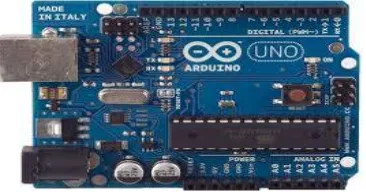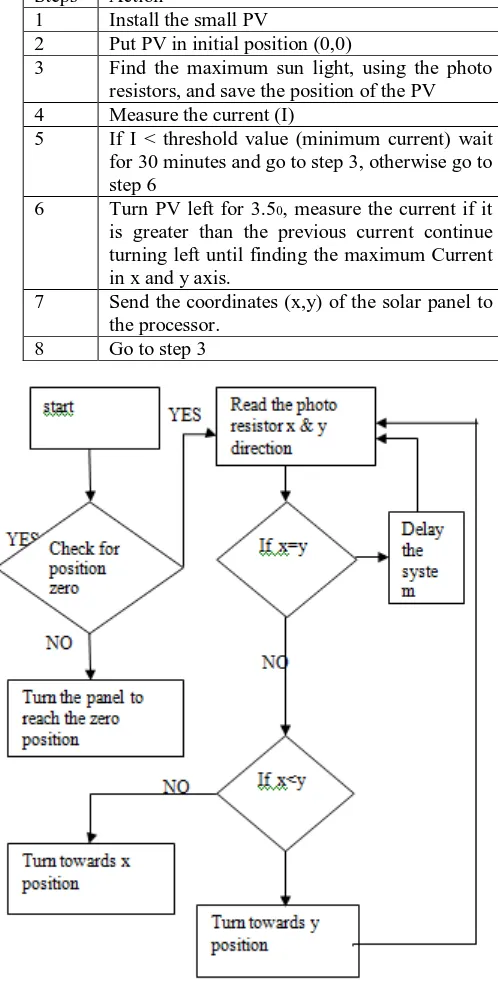Increasing Power Efficiency in Solar Cells
Using Fresnel lens
Ananthi.P1, Muthumeena.M2, Lakshmi.S3, Lavanya.R4, Karthigaiselvi.B5
Assistant Professor, Department of ECE, Sree Sowdambika College of Engineering, Aruppukottai, Tamilnadu,
India 1
Final Year U.G Students, Department of ECE, Sree Sowdambika College of Engineering, Aruppukottai, Tamilnadu,
India2345
ABSTRACT: Solarenergy systems have emerged as source of renewable energy over the past two or three decades, and are now widely used for a variety of industrial and domestic applications. Such systems are based on a solar collector, designed to collect the sun’s energy and convert it into either electrical or thermal energy. In general, the power developed insuch applications depends fundamentally upon electrical power the amount of solar energy captured by the collector, and thus the problem of developing tracking schemes capable of following the trajectory of the sun throughout the course of the day on a year. The aim of this paper is to introduce the SOLAR TRACKING to the existing fixed solar panels, by the way it is maintaining the constant maximum power output. Thus by using this tracking system the conversion efficiency of the solar electric power generation can be increased [9]&[10]. Fresnel lens is used forincreasing the solar panel power by reflections.
KEYWORDS: solar panel, Fresnel lens, ARDUINO UNO, LDR (Light Dependent Resistor), DC gear motor.
I.
I
NTRODUCTIONSolar energy is the energy extracted from the rays issued from the sun in the form of heat and electricity. This energy is essential for all life on Earth. It is a renewable resource which is clean, economical, and less pollution compared to other resources and energy. Therefore, solar energy is rapidly gaining notoriety as an important means of expanding renewable energy resources [1-4]. As such, it plays a vital role in engineering field understand the technologies associated with this area.In this paper, the solar energy for generation of electrical energy is achieved by using the Solar cells. The solar cells receive the solar energy. The solar cells operate on the photo-electric energy by using solar cells principle. The energy from the cells is used to switch ON the lights. At present solar electric power generation systems are having fixed solar panels whose efficiency of generation is less. This problem can be rectified by using solar tracking system and Fresnel lens, and thus maximum power output can be achieved.The ARM processor is used to control the stepper motor[12]. The ARM processor also does the job of fetching the input from the sensor and gives command to the motor to runin order to tackle theChange in the position of the panel. As well as ARDUINO processor is used to control the DC gear motor.[13] Describes the solar tracking system with LDR which will help to keep the solar panels aligned with the sun in order to maximize efficiency. In this paper the above feature is also applied .In the earlier stage the fixed solar panel which can’t move towards more radiated region, the output of the panel is medium level. Above drawbackcan be avoided by usingFresnel lens. It supports to increase the maximum power output. This output power is greater than the power output of fixed solar tracking
II.
D
ESCRIPTIONO
FC
OMPONENTSFollowing major componentsare used for increasing power efficiency in solar cells using Fresnel lens. Such as,
1.Fresnel lens 2.Solar panel
4.ARDUINO UNO 5. DC gearmotor
1. Fresnel lens:
Fig. 1Fresnel lens
Fig. 1 showsthe image of Fresnel lens. It is used for reflectingpurpose [6].A Fresnel lens can be made much thinner than a comparable conventional lens, in some cases it takes the form of a flat sheet, it has long aperture and small focal length.
2.Solar panel:
Fig. 2 Solar Panel
A photovoltaic module or photovoltaic panel is a packaged interconnected assembly of photovoltaic cells, also known as solar cells shown in Fig. 2.A photovoltaic cell is a specialized semiconductor that converts visible light into direct current. Some PV cells can produce DC electricity from infrared or ultraviolet radiation [5]&[6]. Photovoltaic cells are an integral part of solar-electric energy systems, which are becoming increasingly important as alternative sources of power utility. In Fig. 2 shows the generation of DC electricity from light, which is used in many applications such as: charging batteries, powering equipment, etc. Inthis paper the photovoltaic cell is applied for generating power from sun rays.
3.Light Dependent Resistor:
Fig. 3Light Dependent Resistor
Fig. 3 shows the physical structure of LDR.It works based on the variance of resistance value, which under goes to decrease or increasing the incident light intensity. It is also used to detect the light intensity. It acts as a light sensing circuit. It is used in solar street lamps.
4. Arduino Uno:
Fig. 4 shows theArduino system.It provides set of digital and analog I/O pins that can be interfaced to various expansion boards and other circuits, the board includes serial communication interfaces, USB on some models, for loading programs from personal computers. The first Arduino was introduced in 2005, aiming to provide an inexpensive and easy way for notify the professionals to create devices that interact with their environment using sensors and actuators. Common examples of such devices intended for beginner hobbyists include simple robots, thermostats, and motion detectors [7].
Fig. 4Arduino Uno
5.DC gear motor:
Fig. 5 DC gear motor
Fig. 5 shows the physical structure of DC gear motor. The size of the motorvaries based on the size of panel.
III. PROPOSED SYSTEM
Initially the sun rays fall on the solar panel. At that time Light Dependent Resistor (LDR) is set in ON position. The light dependent resistor value increases or decreases according to the intensity of light. This variation in the Arduino controller makes to rotate the dc gear motor. The dc gear motor is attached with the solar panel and hence the panel moves .The optocoupler support the isolation of power circuit and control circuit. Fresnel lens is attached on two sidesof the solar panel for increasing the power generation. And, further increased power is calculated and compared with the output power of the solar panel reading without Fresnel. The output power reading with Fresnel lens is greater than the normal solar panel reading.
IV. CONTROLALGORITHMANDPRIMARYRESULTS
Inorder to demonstrate the efficiency of the proposed system, a control algorithm is generated as shown in TABLE. 1.
TABLE. 1 CONTROL ALGORITHM
Steps Action
1 Install the small PV
2 Put PV in initial position (0,0)
3 Find the maximum sun light, using the photo resistors, and save the position of the PV 4 Measure the current (I)
5 If I < threshold value (minimum current) wait for 30 minutes and go to step 3, otherwise go to step 6
6 Turn PV left for 3.50, measure the current if it
is greater than the previous current continue turning left until finding the maximum Current in x and y axis.
7 Send the coordinates (x,y) of the solar panel to the processor.
8 Go to step 3
V. PRELIMINARYRESULTS
Commonly the output power, reliability and the cost rate play an important role in the successful product. Like as the cost of both system such as fixed solar panel tracking system and our system “increased power efficiency of solar panel by using Fresnel lens” is varied, their results and nature which is referred in two major categories such as,
Cost
Output power
COST
The TABLE. 2 shows that the cost rate of our proposed paper.
TABLE. 2
s. no Component name Rate
1 ARDUINO 600
2 LDR 30
3 DC GEAR MOTOR 50
4 Tracking table 100
5 Fresnel lens 120
Total 900
OUTPUT POWER (In terms of current):
TABLE. 3 shows that the comparison of the normal fixed Photovoltaic cell and our paper such as “Increasing power efficiency solar cell by using Fresnel lens. The tabulation illustrates easyunderstanding about the efficiency of our paper.The output power is maximum in this system. Hence the usage of Fresnel lens solar system will increase the power level.
TABLE. 3
VI. CONCLUSION
This paper reports Fresnel lens based improved structureof solar tracker. The Monitoring controller based on the closed loop algorithm is designed and implemented with ARDIUNO processor. Experimental work has been carried out carefully. By using this paper maximum current can be obtained from solar panel. Solar trackers are used to orient
Time Current using
solar panel (mA)
Current using solar panel with Fresnel lens (mA)
08:00AM 0.42 1.02
09:00AM 0.55 1.15
10:00AM 0.75 1.35
11:00AM 0.81 1.41
12:00AM 0.92 1.52
01:00PM 0.95 1.55
02:00PM 0.88 1.48
03:00PM 0.76 1.36
04:00PM 0.42 1.02
05:00PM 0.23 1.83
06:00PM 0.08 0.68
photovoltaic panels, reflectors, lenses or other optical devices towards the sun. Since the sun’s position in the sky changes with the seasons and the time of day, trackers are used for aligning the collection system to maximize energy production.Operating cost, maintenance costs are minimum as compared to the other type of power generation systems. Pollution free atmospheric condition due to the absence ofsmokes. They have long effective life and is highly reliable. They have a high power.
REFERENCES
[1] A.Zahedi, “Energy, People, Environment, Development of an integrated renewable energy and energy storage system, an uninterruptible power supply for people and for better environment,” The International Conference on Systems, Man, and Cybernetics, 1994. 'Humans, Information and Technology', Vol. 3 pp. 2692-2695, 1994.
[2] R. Singh, and Y.R. Sood, “Transmission tariff for restructured Indian power sector with special consideration to promotion of renewable energy sources”, The IEEE Conference TENCON-2009, pp. 1-7, 2009.
[3] J. Arai, K. Iba, T. Funabashi Y. Nakanishi, K. Koyanagi, and R. Yokoyama, “Power electronics and its applications to renewable energy in Japan, ” The IEEE Circuits and Systems Magazine, Vol. 8, No. 3, pp. 52-66, 2008.
[4] S. Takemaro and Shibata Yukio, “Theoretical Concentration of Solar Radiation by Central Receiver Systems,” The International Journal of Solar Energy, 261-270, 1983.
[5] S. Armstrong and W.G Hurley “Investigating the Effectiveness of Maximum Power Point Tracking for a Solar System”, The IEEE Conference on Power Electronics Specialists, pp.204-209, 2005.
[6] O. Aliman, and I Daut, “Rotation-Elevation of Sun Tracking Mode to Gain High Concentration Solar Energy”, The IEEE International Conference on Power Engineering, Energy and Electrical Drives, pp.551-555, 2007.
[7] A.K. Saxena and V. Dutta, “A versatile microprocessor- based controller for solar tracking”, IEEE Proc., 1990, pp. 1105 – 1109.
[8] P. I. Widenborg, G. Aberle: Polycrystalline Silicon Thin-Film Solar Cells on AIT-Textured Glass Superstrates, Advances in OptoElectronics Journal, Vol. 2007.
[9] P. Turmezei: Chalcogenide Materials for Solar Energy Conversion, ActaPolytechnicaHungarica, Vol.1, No. 2, pp. 13-16, 2004 [9] Solar Tracking System: More Efficient Use of Solar Panels J. Rizk, and Y. Chaiko.
[10] Damm, J. Issue #17, June/July 1990. An active solar tracking system, HomeBrew Magazine.



